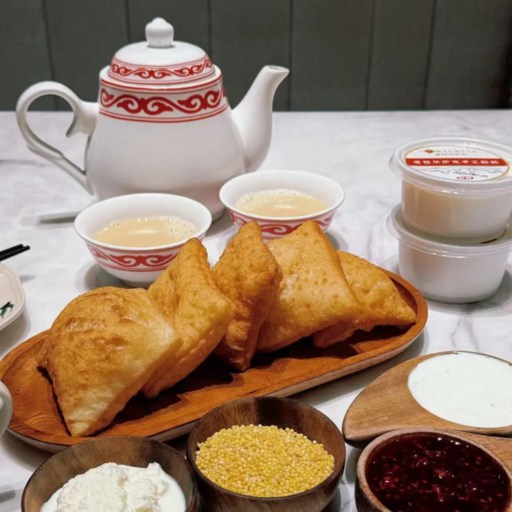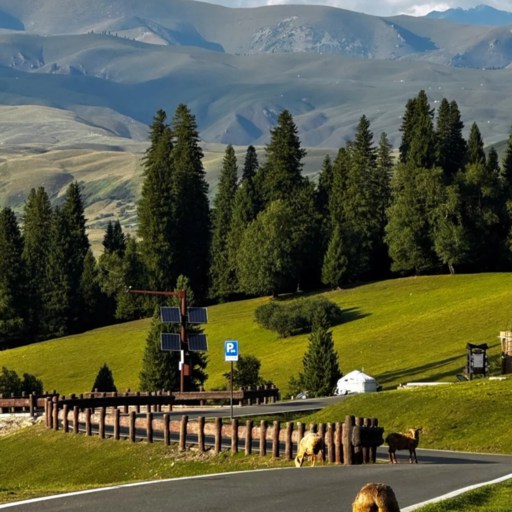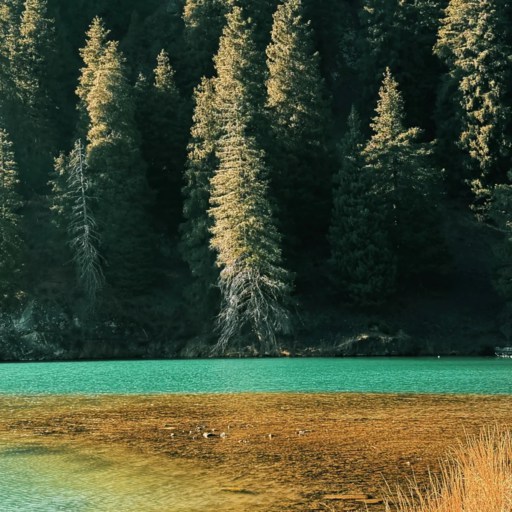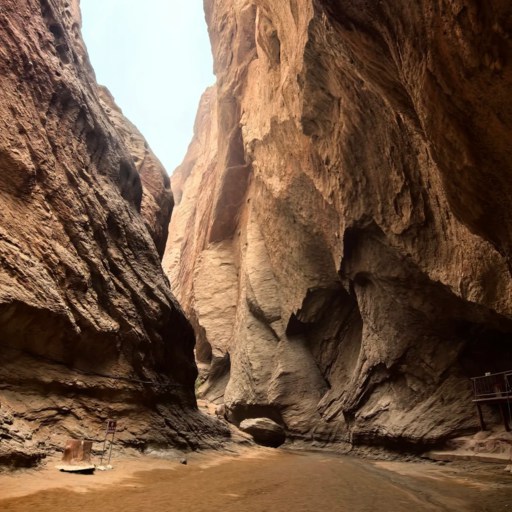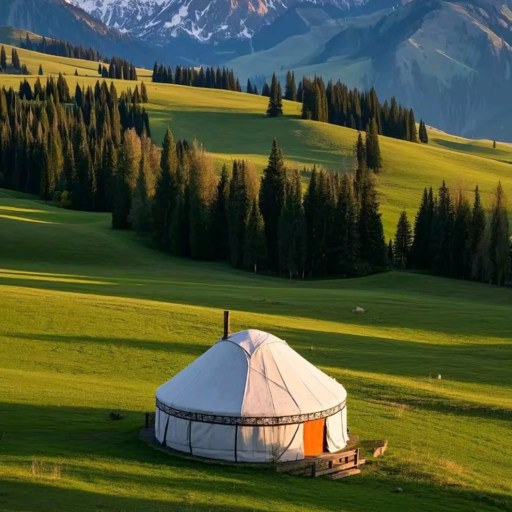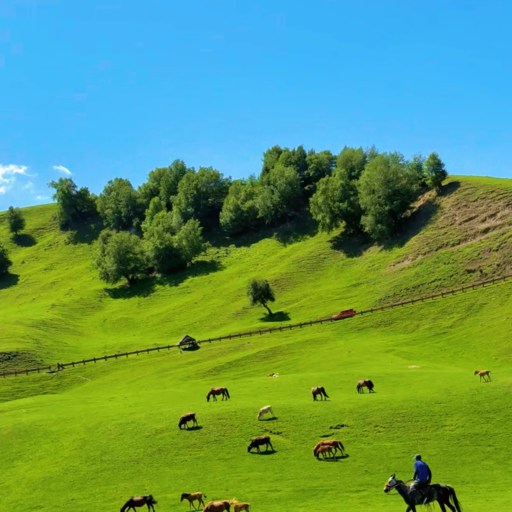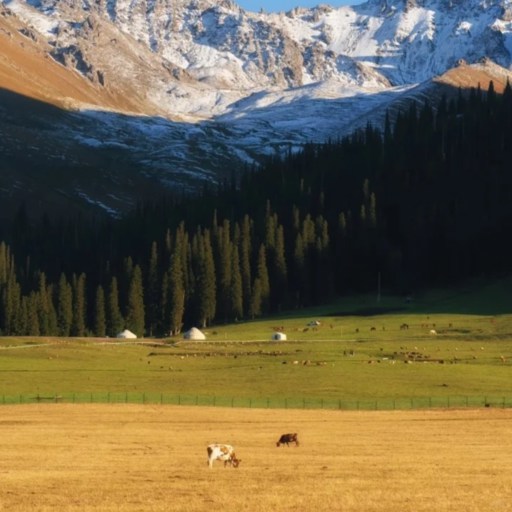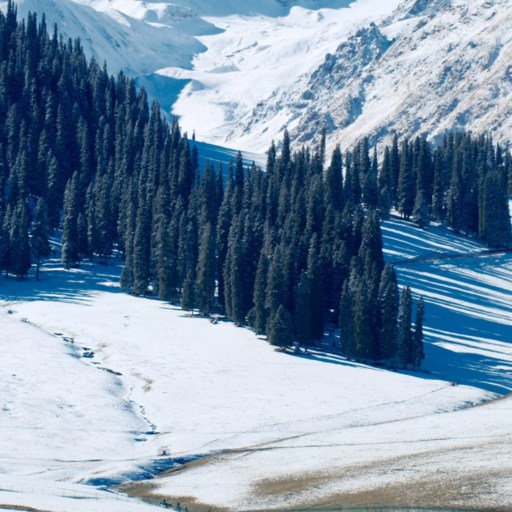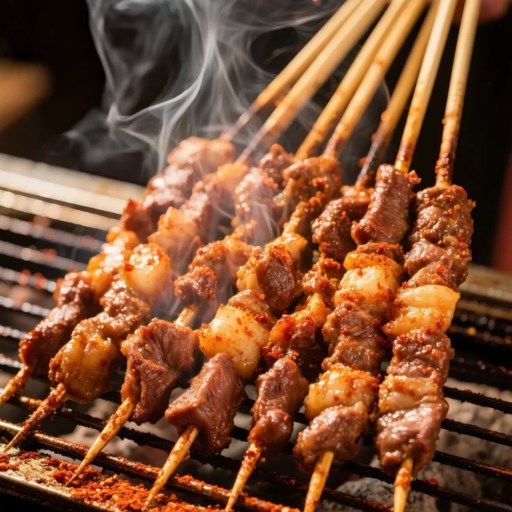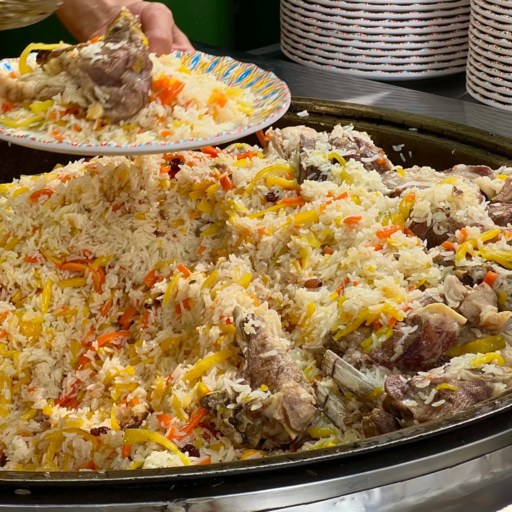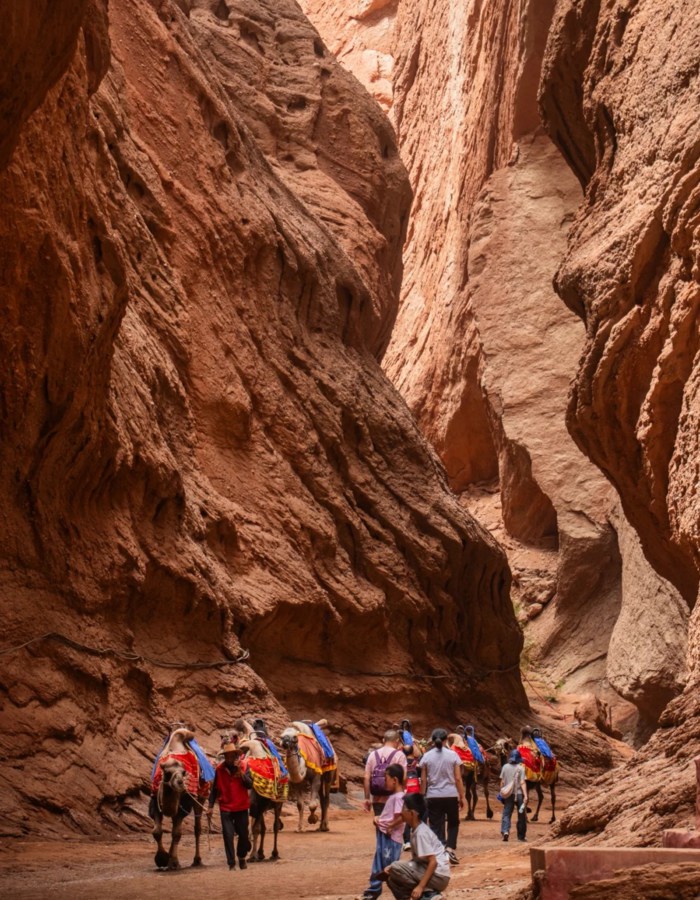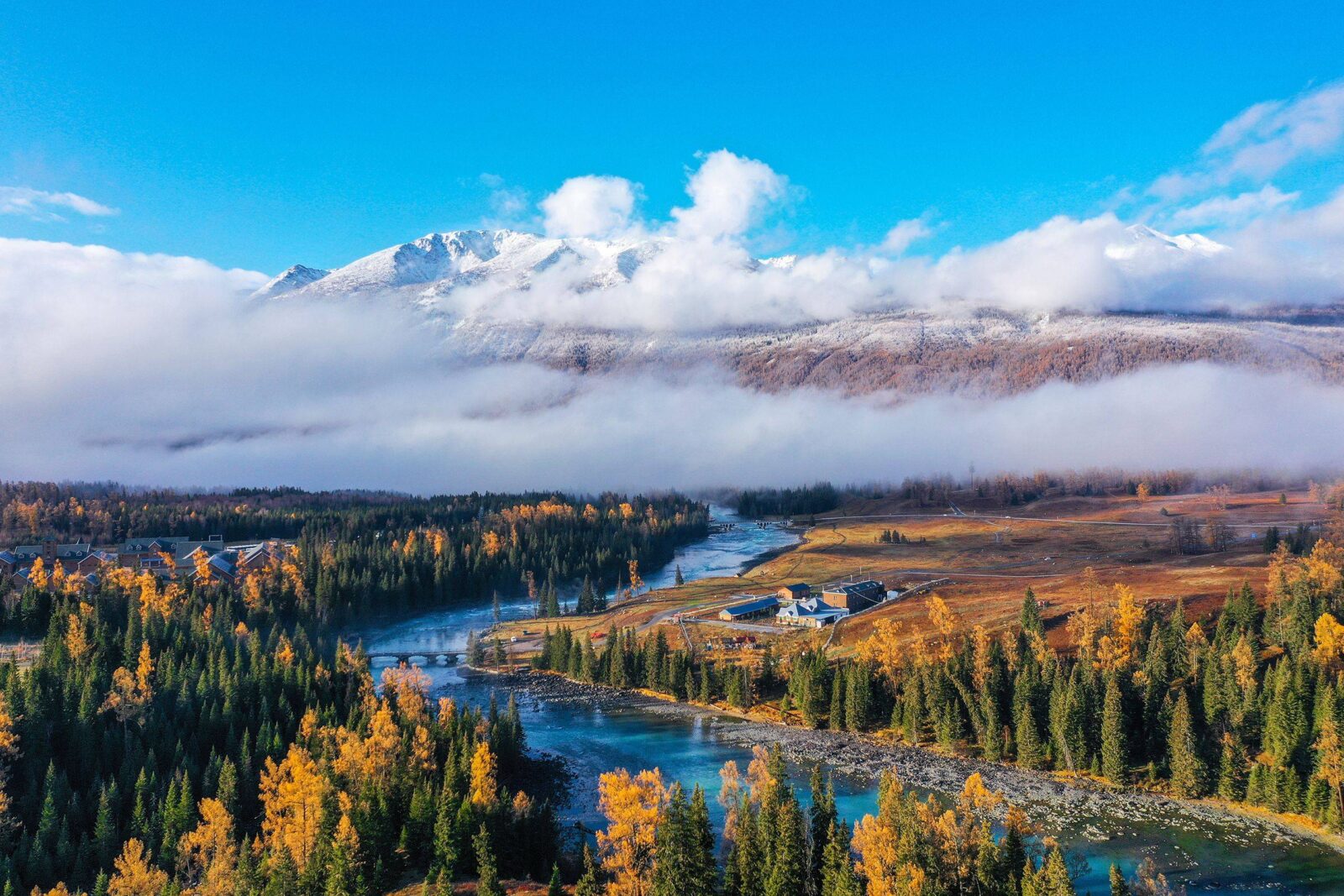
Nalati Grassland
Nalati Grassland does not experience as a postcard, but it breathes. Local people refer to it as Kunes Grassland, which lies in the deepest part of Ili, Xinjiang, where the Tianshan Mountains spurt into the all-green. Even the troops of Genghis Khan, people say, when snow had fallen on these hills, gaped in disbelief as the sunlight oozed and streaming along over them. You understand, more or less, why: the smell of the air is of wet grass and horse sweat, and the horizon is running and running.
It is designated as a national 5A scenic spot today but it has not lost its wild streak. You will see yurts smoking, children shepherding like it is nothing and tourists attempting to capture a far too big sky on any camera. You will be sorry not to miss this place when the rest of China becomes congested.
Quick Facts About Nalati Grassland
| Location | Ili Kazakh Autonomous Prefecture, Xinjiang |
| Altitude | Around 1,800–2,500 m |
| Best Season | June – September |
| Main Activities | Horse-riding, hiking, yurt stay, photography |
| Entrance Fee | 80–100 RMB (plus 30 RMB shuttle) |
| Access | 270 km from Yining, 620 km from Urumqi |
| Accommodation | Nalati Town hotels + Kazakh yurts |
| Coordinates | 43.8° N 83.7° E |
What Makes Nalati Grassland Feel Unlike Anywhere Else
- Tianshan Mountains
- Kazakh Milk Tea
Top Things to Do in Nalati Grassland
- Panlong Valley
- Plants of Tianshan Grand Cayon
- Inside of Tianshan Grand Cayon
Horseback Riding Through Sky-High Meadows
When some people inquire locals about what is the best thing to do here they will most likely smile and point at the horses. Riding is not only a tourist activity, but it is also a part of the heart of the land. All Nalati Grassland tours will include a riding experience although you should not expect some gilted resort trail. In this case, the wind is a grass and leather scent, the saddles tend to be coarse, and the horses are willful. I recall mine--a cynical chestnut--who would not follow the smooth way. It swerved across a ridge, and in the next moment I was panicking. However, on getting to the top, the whole valley was below us and it was worth all the seconds of fear.
The price of most Nalati Grassland rides is approximately ¥80-150 /h (you can check on Ctrip. Reviews on tripadvisor commonly state that the open skyline and family-friendly rides were enjoyed by the tourists, however, they should wear hard-dressed shoes and gloves. The helmets are normally worn or lost. And when the herder tells you to go slow, mind what he says--it may be steep along the edge of the trail, and the wind there cuts even worse than you think it will.
River Valley Trails and Panlong Valley Views
Beyond the horse tracks, a more peaceful loveliness is being woven. The Panlong Valley is the component of the greater Nalati Grassland, it is as though an illustration with watercolor applied to it, winding rivers, and fields woven with yellow wildflowers, and mountains lying in the distance, warm enough to be touched. It is best in the morning, as the fog comes rolling down the slopes like spilled milk. Running water keeps you company, and you will occasionally see a heron going through the mist.
It is compared by some hikers to Switzerland but I would say it is coarser and more sincere. No prepared picnic area, just rocks, moss, and the yak who looks at you in a disapproving manner. Use the little tracks of herders, not Google Maps. And you will find turns and twists where the wind ceases and you will hear no sound other than the ringing of a grazing horse. That is what justifies half of the reason why people fall in love with Nalati.
Paragliding and Summer Grassland Slides
Anyone who is in need of some adrenaline rush finds paragliding over Nalati to be frightening and akin to an addiction. The operators who are located in the vicinity of the observation points ( tickets range: 300-400 yen) assist you in flying over the valley, where the grassland is a green sea. The Tianshan mountains seem too near and the yurts below are dwarfed to dots. The ride is ten minutes long, though it renews your sense of scale.
In case flying is too excessive, use the Nalati Grassland slide, a long chute placed at the top of the hill which is covered with artificial turf and both children and adults ride plastic boards. It is dumb fun, yet when you are riding down when the wind is screaming in your ears and you are hitting the grass with your knees, you understand why locals love it. some herder once made fun and said it was modern horseback. Maybe he was right.
Cultural Encounters: Yurt Stay & Evening Bonfire
The grassland takes a different turn when it gets dark. Nalati Grassland visits most of the time conclude prior to the sunset but an overnight stay is all the difference. A Kazakh yurt (¥250-500/night) that accepts foreigners is rentable, but you have to check in Nalati Grand Hotel or Yurt Camp Nalati on Trip.com because you can be sure that they will accept the passport. The smell in the house is of felt and pine smoke, and you can hear wind rifling along the poles.
When night falls, fire is flicked on the bonfires. Somebody is playing a dombra, the women are singing low Kazakh ballads, and the fires are extending to the stars. I have once joined a performance of people who tried to clap heartily, totally out of sync, and a child corrected my time with a smile. The evening was concluded with milk tea and a vow to come back.
When you arrive with a desire to see as many photos as you want, you will have them. But the best of it is the way it feels to be there, like you are a bit out of balance, really alive and maybe even a bit in love with the sky.
The Four Seasons of Nalati Grassland
Spring – Green Awakening
Melting snow at the end of the month of April means that weather in Nalati Grassland will become coy, with the sun in the morning and drizzle in the mid-day. The first thing to rise is the grass that is a pale green and wet, and the air is very smelly of soil and thawing ice. Mean temperatures range between 5 o C and 12 o C and therefore even the use of gloves is important. The rivers begin to hum and the shepherds mend the fences and the lambs stumble along. In case you happen to be a photographer, be at sunrise. The light in the beginning of the day is spilled honey in the mist, and the fields are painted with fresh paint. One TripAdvisor visitor termed it as a dream before the masses come in and that is exactly the case.
Summer – Wildflowers and Nomad Life
The weather of Nalati Grassland changes rapidly between June and August with a blue sky one day and a rainfall the next. The temperatures are raised to 18 o C to 25 o C and wild flowers cover all the slopes. The movement of the Kazakh nomads is made up of this. You will have yurts springing up as you go to bed, smoke coiling out of the roofs, lazy horsemen. You can hear insects and screams of children flying down hills. Carry a light raincoat and do not believe the forecast it is more deceptive than not. In the case of Nalati Grassland photographs, shoot during this period following rain the clouds appear to be broken and everything is shining.
Autumn – Golden Dreams under Tianshan
Towards the end of September, the valley becomes slow. Trees become copper, and the high grass swings like wheatsheaf of wheat. This is the optimal fall of Nalati Grassland autumn colors: amber fields beneath snow-topped mountains. Mean temperatures reduce to 10 o C to 15 o C, and the wind becomes keen in the night. It is more peaceful, pensive, argues travelers. Before the opening of frosty weather, the natives herd their yurts and drive away their kine. It is the heaven of the photographer; it should be early morning before 10 a.m. when the sun strikes the sideways and lays everything gold.
Winter – Quiet Snow Fields
Nalati is sunk in stillness come winter. The highways are frequently blocked by heavy snow, but when you get there (usually on the Yining side) you will enter another world frozen rivers, horses forcing their way through snow drifts and clear skies almost humming with their purity. The cold falls down to a -10 C or even colder and even breathing is pungent. People rarely visit it but those who do, refer to it as hauntingly beautiful. Forget sneakers, wear snow boots and take hot tea. And winter here is the interlude between the verses of the song, summer,--and that silence, somehow, speaks it all.
Where to Stay and What to Eat Around Nalati Grassland
- Nalati Prairie Yurt Camp
- Grilled Mutton Skewers
- Shou Zhua Fan
Staying in Nalati Town – Comfort and Convenience
Wondering where to be Nalati Grassland, the town is your best place of stay. It is approximately ten minutes away the main gate and it is full of paved roads, cafes and even a couple of surprisingly modern hotels. The majority of visitors visit Nalati Grand Hotel or Tianchi International which are both posted on Trip.com.
and ratified to receive foreigners. It ranges between 350 and 800 yen/night depending on the time of the year. The rooms are not fancy though and hot showers are a luxury after a day of sun and wind. There are small groceries around, selling bottled kumiss (fermented mare milk) and snacks that have a weird flavour of salty popcorn.
Yurt Camps Sleeping under the Stars
In case you prefer not to be that roomy but more sky-like, go to the yurt camps that are scattered in the picturesque part. Some of them such as Nalati Prairie Yurt Camp or Kazakh Folk Village are also open to foreigners (be sure to check listings on Ctrip). Prices are 250-500 a night, with or without breakfast of milk tea and fried bread twists. The stars are so broad at night that they may nearly touch your bosom, and the breeze whistles through the felt walls. I once woke up at 3 a.m. to the sound of hooves and found out a herd was grazing in the outside, so no need to wake up at some early time and use an alarm clock.
The yurts are not so well insulated and even during summers they require warm clothes. There are those which have solar lights; others use candles and the moon. Town is the place to be, in case you like comfort. The thing is that, though you want to be quiet and see the sky, sometimes a night out here turns all your standards upside down.
Local Flavors -Mutton, Milk Tea, and Kazakh Bread
Nalati Grassland cuisine is all about smokes and no frills. Each of the corners reeks of grilled mutton skewers that are being cooked on birchwood. The natives are devotees of the lamb--soft, oily, good with cumin sprinkled over them. Eat it with a plate of salty milk tea and a slice of baursak, the Kazakh fried bread that has the same flavor as the cousins of the doughnuts. Deliveries in yurts are served on metallic trays, and the smell of tea blends with the grass in the outside.
Take the rice you grab with your hands (shou zhua fan) when you come across it--it is a substantial one, covered with carrots and pieces of lamb. And were one to have horse milk wine (kumiss), drink at least a swallow. It is crisp, smoky and oddly invigorating. No fancy china, no hashtags, only plain food that is compatible with wild rhythm of the land.
FAQs About Visiting Nalati Grassland
Q: How do I get to Nalati Grassland from Urumqi?
You can fly from Urumqi to Nalati Airport (about 1 hour) or take a 6–7 hour drive along the G218 highway through the Tianshan range. Buses run daily from Yining too, usually ¥100–150. If you book a Nalati Grassland tour, transportation is often included. The drive itself is part of the magic—mountains, rivers, and open sky everywhere.
Q: When is the best time to visit Nalati Grassland?
The best season for Nalati Grassland is from June to September, when the meadows are green and herders set up yurts. July brings wildflowers, while August offers clear skies for photography. Avoid early spring—the trails are muddy—and winter unless you’re ready for –10°C winds. The grassland weather flips fast, so always pack rain gear.
Q: Is Nalati Grassland worth visiting in autumn?
Absolutely. Nalati Grassland autumn feels golden and calm, with copper hills and fewer crowds. The temperature averages 10–15°C, perfect for hiking or horseback rides. Photographers love this time—soft light, amber tones, and the smell of drying hay. Some yurts close after mid-October, so check availability before you go. Locals call it the most “peaceful” season.
Q: Can foreigners stay overnight inside Nalati Grassland?
Yes, but only at licensed camps and hotels listed on Ctrip. Some yurt camps inside the scenic area accept foreign guests (passport needed at check-in). Prices range from ¥250–500 per night. Others nearby in Nalati Town are easier to book and have private bathrooms. Always confirm before arriving—rules sometimes change by season.
Q: What should I wear or pack for Nalati Grassland?
Layers are key. Bring a windproof jacket, hiking shoes, sunscreen, and maybe gloves. Even in July, nights drop below 10°C. The sun burns fast at altitude, so a hat helps. Locals recommend wet wipes and small cash; Wi-Fi can be patchy. Forget umbrellas—the wind eats them. A thermos of hot tea? Lifesaver.
Q: How long should I spend in Nalati Grassland?
Two full days fit most plans. One for horseback riding and Nalati Grassland slides, another for sunrise or a short hike into the Panlong Valley. Day trips from Yining are possible, but you’ll rush through. Staying overnight lets you catch the bonfire shows and that unreal starry sky—both worth slowing down for.
Q: Is horseback riding safe in Nalati Grassland?
Generally yes, but listen to the herders. Horses here are real working animals, not theme-park ponies. Helmets are sometimes old, so bring your own if possible. Stick to short Nalati Grassland rides if you’re new; longer trails can get steep. A TripAdvisor user joked their horse “knew better paths than the guide”—probably true.
Q: What’s the entrance fee for Nalati Grassland?
Tickets usually cost ¥80–100, plus ¥30 for the shuttle bus inside. Prices change slightly by season. You can book directly at the gate or through Ctrip for convenience. Keep your ticket—it’s checked at multiple entrances. Kids under 1.2 m usually enter free. Considering the view, it’s one of Xinjiang’s best-value landscapes.

